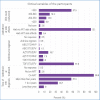MEDICINAL HERBS USED BY HIV-POSITIVE PEOPLE IN LESOTHO
- PMID: 28852728
- PMCID: PMC5566135
- DOI: 10.21010/ajtcam.v13i4.17
MEDICINAL HERBS USED BY HIV-POSITIVE PEOPLE IN LESOTHO
Abstract
Background: The use of medicinal herbs whose efficacy and toxicities are not known by HIV-positive people in Lesotho is a threat to the effectiveness of antiretroviral treatment. This study explored some medicinal herbs used by HIV-positive people in Lesotho and the reasons for their use.
Methods: This was a cross sectional study based on a questionnaire distributed to purposively-sampled HIV-positive people in Leribe and Maseru districts of Lesotho. The participants' socio-demographic and clinical variables were summarized using frequency tables in Stata version 13 statistical software. Data variables for medicinal herbs used, frequency of use, uses by the participants and in the literature, parts of plants used and the method of preparation were also explored.
Results: Out of 400 questionnaires distributed to the participants, 389 were returned with data acceptable for analysis. Ages of the participants ranged from 18 to 75 years (Mean=43 + 11.6). Out of the 272 (69.9%) participants who conceded that they had used medicinal herbs at least once, 30 (7.7%) participants used medicinal herbs frequently while 242 (62.2 %) rarely used the herbs. At least 20 plant species belonging to 16 families were reportedly used by the participants. Asteraceae was the most common plant family reportedly used by the participants. Allium sativum and Dicoma anomala, reportedly used by 21.0% and 14.3% respectively, were the most commonly used medicinal herbs in this population. In addition, boosting the immune system and treating gastrointestinal ailments, apparently cited by 32% and 28% participants respectively, were the most commonly reported reasons for using medicinal herbs.
Conclusion: A considerable proportion (69.9%) of HIV-positive people use medicinal herbs in this population, and 7.7% use them frequently. At least 20 plant species belonging to 16 families were reportedly used by the participants. HIV counselling protocols in Lesotho should emphasize the dangers of using medicinal herbs whose safety and compatibility with antiretroviral drugs is not known. The efficacy and toxicity profiles of the medicinal plants identified in this study need to be investigated. Furthermore, the effects of these plants on antiretroviral treatment outcomes including herb-drug interactions need to be explored.
Keywords: Allium sativum; Anti-retroviral treatment; Dicoma anomala; HIV; Herb-drug interaction; Medicinal herb.
Figures




Similar articles
-
Ethnobotanical survey of medicinal plants used in the Maseru district of Lesotho.J Ethnopharmacol. 2015 Jul 21;170:184-200. doi: 10.1016/j.jep.2015.04.047. Epub 2015 May 7. J Ethnopharmacol. 2015. PMID: 25957810
-
Ethnobotanical study of nutri-medicinal plants used for the management of HIV/AIDS opportunistic ailments among the local communities of western Uganda.J Ethnopharmacol. 2013 Nov 25;150(2):639-48. doi: 10.1016/j.jep.2013.09.017. Epub 2013 Sep 26. J Ethnopharmacol. 2013. PMID: 24076461
-
Ethnobotanical study of indigenous knowledge on medicinal and nutritious plants used to manage opportunistic infections associated with HIV/AIDS in western Uganda.J Ethnopharmacol. 2014 Aug 8;155(1):194-202. doi: 10.1016/j.jep.2014.05.012. Epub 2014 May 24. J Ethnopharmacol. 2014. PMID: 24862490
-
Warfarin interactions with medicinal herbs.Nat Prod Commun. 2014 Aug;9(8):1211-6. Nat Prod Commun. 2014. PMID: 25233607 Review.
-
An overview on ethnobotanico-pharmacological studies carried out in Morocco, from 1991 to 2015: Systematic review (part 1).J Ethnopharmacol. 2021 Mar 1;267:113200. doi: 10.1016/j.jep.2020.113200. Epub 2020 Aug 1. J Ethnopharmacol. 2021. PMID: 32750461
Cited by
-
Prevalence, Perception and Predictors of Concomitant Herbal Medicine Use among HIV/AIDS and Tuberculosis Patients in Metekel Zone, Northwest Ethiopia: A Cross-Sectional Study.Evid Based Complement Alternat Med. 2022 Nov 17;2022:8235229. doi: 10.1155/2022/8235229. eCollection 2022. Evid Based Complement Alternat Med. 2022. PMID: 36437829 Free PMC article.
-
Cancer and Traditional Medicine: An Integrative Approach.Pharmaceuticals (Basel). 2025 Apr 28;18(5):644. doi: 10.3390/ph18050644. Pharmaceuticals (Basel). 2025. PMID: 40430464 Free PMC article. Review.
-
The prevalence and socio-demographic correlates of hypertension among women (15-49 years) in Lesotho: a descriptive analysis.BMC Public Health. 2022 Mar 22;22(1):562. doi: 10.1186/s12889-022-12960-0. BMC Public Health. 2022. PMID: 35317759 Free PMC article.
References
-
- African Technology Policy Studies. Analysis of Traditional Healers in Lesotho: Implications on Intellectual Property Systems. 2013 [Pitso Masupha, Lefa Thamae, Mofihli Phaqane], ATPS Working paper 68.
-
- Amin T, Bhat S. V, Gullería S. Role of Functional Foods and Micronutrients in Reducing HIV Progression. Indian Horticulture Journal. 2012;2(3 and 4):94–97.
-
- Asres K, Bucar F, Kartnig T, Witvrouw M, Pannecouque C, De Clercq E. Antiviral activity against human immunodeficiency virus type 1 (HIV-1) and type 2 (HIV-2) of ethnobotanically selected Ethiopian medicinal plants. Phytotherapy Research. 2001;15(1):62–69. - PubMed
MeSH terms
Substances
LinkOut - more resources
Full Text Sources
Other Literature Sources
Medical
